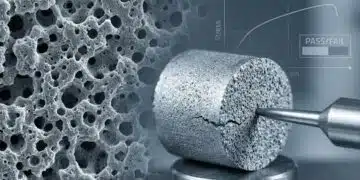YAGEO, a leader in advanced capacitor technology, continues to push the boundaries of innovation with its latest addition to the AAR8S Rectangular Aluminum Electrolytic Capacitor family.
AAR8S, the industry’s first-to-market rectangular aluminum electrolytic surface-mount capacitor, offers high volumetric efficiency, high reliability, and ease of thermal management, solidifying YAGEO’s position at the front of next-generation capacitor solutions.
Why Rectangular Capacitors?
The rectangular form factor is a game-changer in power electronics.
These capacitors provide superior volumetric efficiency, high ripple current handling, and robust vibration resistance, making them ideal for demanding applications such as automotive, industrial power supplies, renewable energy systems, and data centers.
Additionally, their large flat surface area enables seamless integration with heat sinks, enhancing thermal dissipation and increasing ripple current capability or increasing life with the same ripple current.
The introduction of the AAR8S further expands YAGEO’s rectangular aluminum electrolytic capacitor family, offering engineers and designers a surface mount component,more flexibility due to the rectangular shape, improved thermal performance, and greater efficiency for their power electronics applications.
As automotive and industrial power systems continue to evolve, YAGEO remains committed to delivering innovative capacitor solutions that meet the industry’s growing requirements.
Key Benefits of the AAR8S:
- Surface Mount Design for automated assembly and compact integration
- AEC-Q200 qualified, ensuring reliability in automotive environments
- High ripple current capability for demanding power applications
- Low-profile rectangular shape for space-constrained designs
- Optimized heat dissipation for better thermal management
Overview of KEMET’s Rectangular Capacitor Portfolio
APL90 – Compact 48V Polymer Capacitor with High Ripple Capability
The APL90 is an AEC-Q200 qualified aluminum polymer capacitor designed for 48V automotive and industrial applications. Its rectangular shape allows for efficient stacking and heat sink integration, optimizing thermal performance. With high ripple current capability (up to 26A) and robust vibration resistance (20g), it is ideal for DC-link in MHEV inverters, motor drives, and data center power supplies.
Datasheet: KEM_A4121_APL90.pdf
APL9V – High-Voltage Polymer with Superior Thermal Management
The APL9V is a high-voltage aluminum polymer capacitor designed for applications up to 250V (or 500V in series). Its solid polymer technology enables exceptional ripple current performance. This coupled with vibration resistance, makes it suitable for HV inverters, e-compressors, and motor control applications.
Datasheet: KEM_A4132_APL9V.pdf
AAR70 – Robust Automotive-Grade Solution
The AAR70 is a reliable automotive-grade aluminum capacitor offering a 10,000 hour lifespan at 85°C, making it ideal for long-term, high-ripple current applications. Its shape allows easy stacking and efficient heat dissipation when used with a heat sink.
Datasheet: KEM_A4107_AAR70.pdf
AAR80 – Extended Temperature Capability
For applications requiring operation up to 105°C, the AAR80 provides high vibration resistance (up to 20g) and good ripple current performance, making it a versatile choice for automotive and industrial environments.
Datasheet: KEM_A4118_AAR80.pdf
AAR7V – High Voltage, High Performance
With a voltage rating of 500VDC, the AAR7V is a high-voltage aluminum capacitor engineered for EV powertrains, industrial power supplies, and renewable energy applications. It features a 10,000 hour lifespan at 85°C, excellent ripple current handling, and optimized thermal performance.
Datasheet: KEM_A4126_AAR7V.pdf
AAR8S – The Industry’s First Rectangular SMD Aluminum Capacitor
The AAR8S marks a significant advancement in aluminum capacitor technology. This first-to-market rectangular SMD aluminum capacitor provides high capacitance, excellent ripple current capability, and superior thermal efficiency. With a low-profile design, it is ideal for applications where height constraints are critical.
Datasheet: KEM_A4139_AAR8S.pdf






























